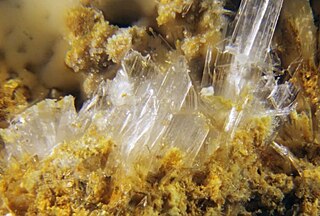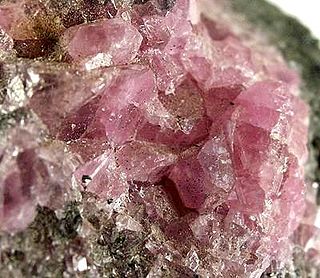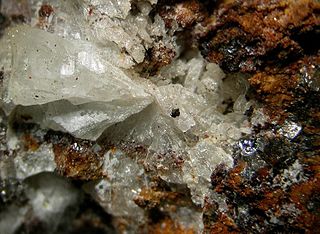Related Research Articles

Euxenite, or euxenite-(Y), is a brownish black mineral with a metallic luster.

Germanite is a rare copper iron germanium sulfide mineral, Cu26Fe4Ge4S32. It was first discovered in 1922, and named for its germanium content. It is only a minor source of this important semiconductor element, which is mainly derived from the processing of the zinc sulfide mineral sphalerite. Germanite contains gallium, zinc, molybdenum, arsenic, and vanadium as impurities.

Fichtelite is a rare white mineral found in fossilized wood from Bavaria. It crystallizes in the monoclinic crystal system. It is a cyclic hydrocarbon: dimethyl-isopropyl-perhydrophenanthrene, C19H34. It is very soft with a Mohs hardness of 1, the same as talc. Its specific gravity is very low at 1.032, just slightly denser than water.

Tusionite is a rare colorless to transparent to translucent yellow brown trigonal borate mineral with chemical formula: MnSn(BO3)2. The mineral is composed of 18.86% manganese, 40.76% tin, 7.42% boron, and 32.96% oxygen. It is a late stage hydrothermal mineral and occurs rarely in granite pegmatites in miarolitic cavities.
Carobbiite, chemical formula KF, is a rare, soft, colourless cubic mineral. It is found at Monte Somma, Somma-Vesuvius Complex, Province of Naples, Campania, Italy. It was discovered in 1956 by Italian geologist Guido Carobbi (1900–1983). It has also been reported from Hokkaido, Japan.

Empressite is a mineral form of silver telluride, AgTe. It is a rare, grey, orthorhombic mineral with which can form compact masses, rarely as bipyramidal crystals.

Livingstonite is a mercury antimony sulfosalt mineral. It occurs in low-temperature hydrothermal veins associated with cinnabar, stibnite, sulfur and gypsum.

Corderoite is an extremely rare mercury sulfide chloride mineral with formula Hg3S2Cl2. It crystallizes in the isometric crystal system. It is soft, 1.5 to 2 on the Mohs scale, and varies in color from light gray to black and rarely pink or yellow.

Titanowodginite is a mineral with the chemical formula MnTiTa2O8. Titanowodginite has a Mohs hardness of 5.5 and a vitreous luster. It is an iridescent dark brown to black crystal that commonly forms in a matrix of smoky quartz or white beryl in a complex zoned pegmatite.

Gunningite is one of the minerals in the Kieserite group, with the chemical formula (Zn,Mn2+)SO4·H2O. Its name honours Henry Cecil Gunning (1901–1991) of the Geological Survey of Canada and a professor at the University of British Columbia.

Thomasclarkite-(Y) is a rare mineral which was known as UK-93 until 1997, when it was renamed in honour of Thomas H. Clark (1893–1996), McGill University professor. The mineral is one of many rare-earth element minerals from Mont Saint-Hilaire. The only reported occurrence is in an alkalic pegmatite dike in an intrusive gabbro-nepheline syenite.
Vulcanite is a rare copper telluride mineral. The mineral has a metallic luster, and has a green or bronze-yellow tint. It has a hardness between 1 and 2 on the Mohs scale. Its crystal structure is orthorhombic.

Hodgkinsonite is a rare zinc manganese silicate mineral Zn2MnSiO4(OH)2. It crystallizes in the monoclinic system and typically forms radiating to acicular prismatic crystals with variable color from pink, yellow-red to deep red. Hodgkinsonite was discovered in 1913 by H. H. Hodgkinson, for whom it is named in Franklin, New Jersey, and it is only found in that area.

Baumhauerite (Pb3As4S9) is a rare lead sulfosalt mineral. It crystallizes in the triclinic system, is gray-black to blue-gray and its lustre is metallic to dull. Baumhauerite has a hardness of 3.

Kegelite is a complex silicate mineral with formula Pb8Al4Si8O20(SO4)2(CO3)4(OH)8.

Danalite is an iron beryllium silicate sulfide mineral with formula: Fe2+4Be3(SiO4)3S.

Fluellite is a mineral with the chemical formula Al2(PO4)F2(OH)•7H2O. The name is from its chemical composition, being a fluate of alumine (French).

Stillwellite-(Ce) is a rare-earth boro-silicate mineral with chemical formula (Ce,La,Ca)BSiO5.
Banalsite is a rare barium, sodium aluminium silicate mineral with formula: BaNa2Al4Si4O16. Banalsite is a tectosilicate of the feldspar group.

Minrecordite, CaZn(CO3)2, is a very rare mineral belonging to the dolomite group, the member with Ca and Zn. It was discovered, associated with dioptase, in a specimen from the Tsumeb mine (Namibia), which is consequently its type locality. Its name is a tribute to The Mineralogical Record magazine, representing the collaboration between professional and amateur mineralogists. In this locality it is associated primarily with dioptase, and less frequently with duftite, calcite and malachite. It is a rare mineral, which has been found only in a few deposits in the world. In addition to the type locality, it appears in the Preguiça mine, in Moura, district of Beja (Portugal).
References
- ↑ Warr, L.N. (2021). "IMA–CNMNC approved mineral symbols". Mineralogical Magazine. 85 (3): 291–320. Bibcode:2021MinM...85..291W. doi: 10.1180/mgm.2021.43 . S2CID 235729616.
- ↑ http://webmineral.com/data/Temagamite.shtml Webmineral data
- 1 2 http://rruff.geo.arizona.edu/doclib/hom/temagamite.pdf Mineral Handbook
- 1 2 http://www.mindat.org/min-3908.html Temagamite: Temagamite mineral information and data Retrieved on 2007-08-30
- ↑ http://rruff.geo.arizona.edu/doclib/cm/vol12/CM12_193.pdf Canadian Mineralogist, Vol. ll pp. 193-198 (1973)